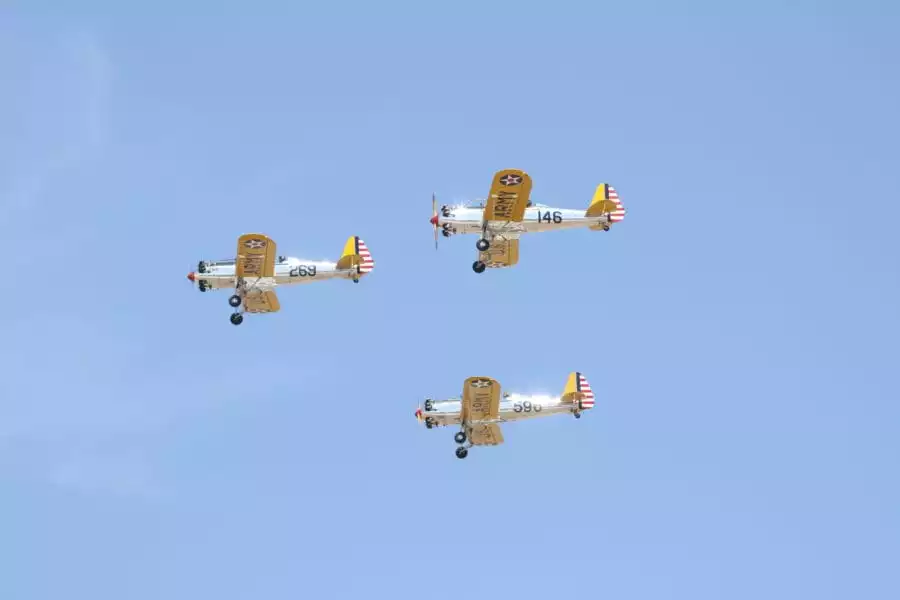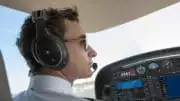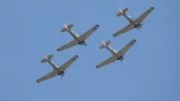Most Common Types of Wing Flaps
When you watch an aircraft prepare for takeoff or approach the runway for landing, one of the most visually striking adjustments is the movement of its wing flaps. These seemingly small modifications to the wings’ shape are crucial for controlling lift and stability during critical phases of flight. It’s like witnessing a bird adjusting its feathers—only in this case, it’s a feat of engineering meeting nature’s inspiration head-on.
Understanding what happens beneath those vast metal wings involves delving into the sophisticated world of aerodynamics and mechanical design. The interplay between various types of flaps on airplane wings can seem as complex as a ballet, yet it follows precise physical laws that keep planes aloft and bring them down safely.
Whether you’re an aviation aficionado, an aspiring pilot, or just plain curious about the orchestration happening above you, strap in. We’re taking off on an exploration into some vital components responsible for air travel as we know it – wing flaps. Discovering their designs and purposes not only sheds light on how airplanes defy gravity but also allows us to appreciate even more the marvels of human ingenuity in our skies.
Let’s embark together on this fascinating journey through airflow and innovation where we’ll unlock the secrets behind these unsung heroes: wing flaps. They may indeed hold part of the magic – or rather science – that enables a giant metallic structure to rise gracefully into the sky.
4 Common Types of Wing Flaps (And How They Affect Flight)
Aircraft wing flaps are pivotal elements allowing pilots to manipulate lift and drag permitting safe takeoffs, steady flights, and smooth landings. Each flap type boasts unique characteristics tailored to serve specific aerodynamic needs. Here’s an enlightening peek at four common varieties:
- Plain or Conventional Flaps act by increasing the curvature or camber of the wing, boosting its lift at lower speeds which is indispensable during takeoff and landing.
- Split Flaps descend from below the wing with simplicity on their side, creating high drag with moderate lift increase primarily beneficial during descent.
- Slotted Flaps, with their clever hinge design enabling a slot formation when extended allowing smoother airflow over themselves—it’s all about producing considerable lift without excessive drag.
- Fowler Flaps, being highly engineered sliding mechanisms bringing out additional surface area as well as camber modification; they allow significant lift enhancement while carefully managing drag—a delicate balance crucial at different stages of flight.
Each flap type modifies airflows around wings differently—yet harmoniously—to support aircraft during various flying stages efficiently accommodating operational necessities under fluctuating airborne conditions.
Soaring across skies thrillingly relies on manipulating subtle angles and surfaces in concert with physical forces! Each flap choice embodies an exquisite piece within this grand aerial symphony resonant from tarmac ascensions to cloud-dancing maneuvers right up until every gentle touchdown back upon earth soils.
By dissecting these staple flap forms’ mechanics further deepens our grasp on how these cleverly crafted implements ensure towering feats remain securely tethered within realms of reliability each time wheels leave ground trailing save passage through air streams above.
1. Plain or Conventional Flaps
Plain, also known as conventional flaps, represent the most basic type of flaps employed on aircraft wings. Their design is straightforward – imagine a hinged portion at the back end of the wing which can be extended downward into the airstream during flight.
When these flaps are deployed, they increase both the surface area and camber of the wing. Camber refers to the curvature of an airfoil from its leading edge to its trailing edge, influencing its lifting properties.
Understanding How They Function
Plain flaps work by changing the wing’s geometry:
- When extended, they create a larger wing surface area, thereby generating more lift.
- This extension leads to a higher angle of attack — or in simple terms, it tilts the wing up in relation to oncoming wind flow.
- An increased camber results as well, enhancing lift further primarily because there’s more curvature for airflow interaction.
This is particularly helpful during takeoff and landing scenarios where slow speeds require additional lift to keep the aircraft safely buoyant. However, deploying these flaps isn’t free from consequences; it also results in increased drag which pilots need to manage carefully.
In essence, plain flaps are akin to opening an umbrella against the wind; you catch more air and thus can lift easier but do have to contend with resistance pushing you back. It’s all about striking that delicate balance between achieving enough uplift for manoeuvres without sacrificing too much speed due to drag.
2. Split Flaps
Split flaps are a distinctive component seen on many aircraft, and they play a crucial role in the aerodynamics of flight. What sets split flaps apart from their wing flap counterparts is their unique design structure, which allows for significant changes to the plane’s lift and drag characteristics.
Design and Operation
The design of the split flap is both simple and ingenious. Mounted on the bottom edge of the airplane’s wing, this type of flap hinges downwards to create an opening between itself and the rest of the wing. When deployed, it increases the surface area subjected to airflow on the underside of the wing while simultaneously disturbing air over the top; this results in increased lift.
While more efficient styles have come into use, you can still spot split flaps on vintage or smaller aircraft due to their relatively straightforward manufacturing process compared to more complex types like slotted or Fowler flaps. A split flap airplane typically showcases these under its wings as robust panels that visibly hinge away when activated—easy to recognize even for aviation novices.
Advantages in Flight Profiles
Split flaps profoundly alter an aircraft’s performance during critical phases like takeoff and landing:
- Takeoff: As speed builds up along the runway, deploying split flaps helps generate lift sooner, allowing for shorter takeoff runs—an advantage on shorter airstrips or when a quick ascent is needed.
- Landing: On approach for landing, greater lift at low speeds keeps an airplane stable and controllable as it descends toward the runway.
However, since activating split flaps enlarges a segment of a plane’s profile exposed to air currents underneath, there’s also additional drag—which isn’t necessarily a bad thing when slowing down is precisely what you want during landing procedures.
Balancing Performance Trade-offs
Despite their benefits, split flaps do introduce some penalties too. The extra drag produced when they are extended makes them less desirable than other types of flaps for continuous deployment during cruising flight—a balanced action must be taken by pilots using this mechanism.
An experienced split flap aircraft pilot knows how much to rely on these devices considering different weights carried onboard or varied weather conditions. They adjust flap deployment carefully so that each flight phase benefits from optimal control response without sacrificing too much speed or fuel efficiency.
In summing up this section about split flaps, think of them as one piece in a grand airborne puzzle—their purpose is not merely lifting but manipulating airflow patterns around wings at decisive moments. This grants airplanes elevated realms of maneuverability where precision counts most: near terra firma during spirited dances with gravity just after departure and prior touch-down.
3. Slotted Flaps
When we turn our attention to slotted flaps, it’s like opening a new chapter in the playbook of aerodynamics. This ingenious adaptation is fundamental for improved lift during crucial phases of flight such as takeoff and landing.
Slotted flaps have a unique design that sets them apart from other types. When extended, they create a narrow slot between the flap and the wing. This passageway is not merely a gap but plays an essential role in airflow management.
Let’s delve into how these marvels work:
- Aerodynamic Magic: As the flap lowers, air slips through the slot and speeds up, reducing turbulence behind the wing by re-energizing the boundary layer – essentially a curtain of air close to the surface of the wing.
- Increased Lift: This controlled rush of air interacts with slower-moving air on top, delaying airflow separation. The result? An uptick in lift that can be as much as 50 percent greater than with plain flaps!
- Single Slotted Flaps Advantage: Among their siblings in the flap family, single slotted flaps strike an admirable balance between complexity and effectiveness. They’re easier to manufacture than more intricate double-slotted or triple-slotted versions yet still provide ample lift and drag necessary for short-field takeoffs and cushy landings.
Understanding single slotted flaps unlocks why they’re favored by many aircraft designs; they offer improved performance without overcomplicating mechanisms or maintenance demands – quintessential features when flying high demands flawless function paired with simplicity.
4. Fowler Flaps
Fowler flaps are truly a marvel when it comes to the ingenious design and functionality provided in aircraft control surfaces. This type of flap is distinct; not only does it hinge down, but it also slides backward along tracks or rollers. As someone fascinated by aviation innovation, I find the engineering behind these components absolutely captivating.
So, let’s look closer at how fowler flaps work and why they’re so beneficial:
- Increased Lift: When I say Fowler flaps increase lift, trust me – they really do! By extending away from the wing, they expand the wing area which creates additional lift. It’s this ability that makes them an irreplaceable feature during slow speeds like approach and takeoff.
- Drag Management: Although adding a component outward could add drag, the genius here is in their gradual deployment ability letting pilots control just how much extra surface area they need – maximizing lift while keeping drag within limits.
- Enhanced Control: Aided by incrementally adjustable settings, pilots can fine-tune their flight approach with precision – giving airflow more input areas over the wings for maintained controllability even at lower airspeeds.
Fowler flaps play a crucial role especially during those critical phases of flight where dependable aerodynamic performance is most required – something any pilot would greatly appreciate. These features make Fowler flaps an essential type of flap for larger aircraft that require optimal performance across varying airspeeds during complex maneuvers commonly experienced in today’s bustling skies.
What Is a Wing Flap?
If you’ve ever sat by the window seat on an airplane, chances are you’ve noticed panels on the wings that extend and retract at various points during the flight. These components are called wing flaps, and they are pivotal to an aircraft’s performance.
A wing flap is essentially a high-lift device used to increase the lift of an aircraft wing at a given airspeed. Think of them like the adjustable parts of a bird’s wing, allowing for more controlled flying maneuvers. They come into play primarily during takeoff and landing—critical phases of flight where control and lower speed are paramount.
During takeoff, flaps are extended to generate additional lift, thereby requiring shorter runway lengths. In contrast, during landing, extending the flaps increases the drag force acting on the aircraft which helps in reducing speed while also creating greater lift at slower speeds. This dual role makes them indispensable for safe and efficient flying.
Flaps aren’t just uniform sheets bending downwards; they’re meticulously designed varying shapes catering to different aerodynamic needs. The design differences affect how air flows over and under the wing surface, ultimately influencing an aircraft’s performance. Later in this article, we’ll delve deeper into the different types of flaps and how each uniquely affects an airplane’s flight capabilities.
So when pondering what is flap in aircraft next time you fly, appreciate these critical components as they work subtly yet significantly behind the scenes or rather beneath the wings, balancing lift forces and giving pilots better control over their aerial steeds.
How do Different Styles of Wings Affect Flight?
When it comes to aircraft, wings are not created equal. The shape, size, and style of a wing can drastically alter how an airplane flies. Each design has its unique advantages that engineers consider when constructing an aircraft to meet specific requirements.
Importance of Wing Design
The design of a wing is pivotal in determining the plane’s lift characteristics, fuel efficiency, speed, and ability to take off or land on short runways. For instance:
- Straight Wings: These wings extend perpendicularly from the fuselage and are prevalent on slow-flying planes. They provide excellent control at low speeds which is perfect for learners and small aircraft.
- Swept-back Wings: Most commonly seen on commercial jet airliners, these wings tilt backward to reduce drag at high speeds making them ideal for long-haul flights.
- Delta Wings: Often found on supersonic jets, their triangular shape distributes weight more evenly across the wing’s surface providing stability at various speeds.
Adaptability of Wing Flaps
In addition to the overall wing structure, the inclusion and style of wing flaps play a crucial role in flight performance. Flaps allow wings to adapt their shape according to flight conditions by altering lift generation and drag characteristics. Here’s what different flap designs bring to the table:
- Increased Lift: Extending flaps increase the curvature of the wing, enabling the plane to generate more lift at lower speeds which is essential during takeoff and landing.
- Controlled Descent: By generating more drag while maintaining lift, pilots can steepen descent angles without increasing airspeed—a prime concern when landing.
By understanding how different wing styles and flaps work together, pilots can maximize an aircraft’s performance under varying conditions — whether it’s cruising above oceans or maneuvering through tight airspace corridors. This synergy between aerodynamics and aviation technology ensures that every journey we undertake in the skies is as safe and efficient as possible.
Which Type of Wing Flaps Are Most Effective?
The conversation regarding the effectiveness of wing flaps often turns to a blend of aerospace expertise and practical flight dynamics. To get straight to the point, no single type of flap is universally “most effective,” as the efficiency largely depends on the specific requirements of the aircraft and its operational regime.
- Plain or Conventional Flaps: Create extra lift at low speeds, meaning they’re pretty effective for smaller airplanes that don’t operate at high altitudes or speeds.
- Split Flaps offer more drag with minimal added lift. These are less common today but served well during their time, particularly in early combat aircraft where abrupt speed reduction was advantageous.
In the context of commercial airliners, slotted and Fowler flaps have carved out distinct reputations for effectiveness:
- Slotted Flaps work wonders in increasing lift without creating too much additional drag. This efficiency makes them a favored option for planes that require a short takeoff or landing distance but also need to sustain economical cruise speeds.
- Fowler Flaps are known for their ability to significantly increase both lift and wing area, providing optimal conditions during critical phases like takeoff and landing. Moreover, thanks to their multi-segment deployment capability, they offer fine-tuned control over flight performance.
When considering military jets or agile aircraft requiring rapid maneuverability combined with stout low-speed handling characteristics, other specialized flap types might be considered “most effective.” Such planes might utilize a combination of different flap technologies tailored to suit their unique performance envelope.
Determining which type reigns supreme in terms of efficacy involves examining an aircraft’s mission profile – from cargo carriers needing short runway lengths to supersonic fighters designed for exacting agility. Therefore, it’s vital to understand that airframe design intentions drive flap innovation toward highly suited solutions rather than pursuing a one-size-fits-all approach.
Slotted Fowler Flaps
By adding slots to Fowler flaps, this design enhances what is already considered highly effective. When extended into positions where high angles could disrupt airflow causing separation and turbulence – which are undesirable – these slots direct high-energy air from under the wing up over it. This stream sustains smoother flow even at steep angles conducive for short take-offs and tight landings.
This clever configuration demonstrates why slotted Fowler Flaps are commonly found gracing long-haul airliners’ wings; they marry amplified lifting prowess with mitigated drag effects in a harmonious balance ideal for such substantial crafts.
As we ponder all influences – aerodynamic principles, specific aircraft roles, environmental considerations – it becomes evident there isn’t one unequivocally “best” design. However, for sheer adaptability across diverse aviation demands, Fowler and Slotted Fowler Flaps do emerge as notably efficacious contenders amidst a broad array of applications thanks to their advanced properties enhancing essential flight characteristics safely and reliably.
What are the flaps on the wings of an aircraft?
When you watch an aircraft prepping for takeoff, or begin its graceful descent towards a runway, you might notice panels at the back edge of the wings extending outward or downwards. Those panels are called flaps—specifically, aeroplane wing flaps—and they play a crucial role in controlling the plane’s lift and drag properties.
Flaps of aircraft are hinged surfaces set along the trailing edge—the rear section—of airplane wings. They’re designed ingeniously to enhance the wing area and change the shape of the airfoil during critical phases of flight: takeoff and landing. By doing so, these versatile components allow planes to maintain lift at lower speeds, making it safe to ascend from shorter runways or glide more slowly onto them when arriving.
While each type has a distinct mechanism and effect on airflow, all flaps serve a similar function in providing pilots with greater control over the aircraft’s performance under varying conditions. So whenever you see those panels adjust their position as an airplane prepares for takeoff or approaches landing, know that it’s more than mechanical choreography; it’s engineering brilliance at work ensuring your safety and comfort as you journey through the skies.
What is the Purpose of a Flap on an Airplane Wing?
When you’re hustling through the airport, eagerly awaiting to board your flight, there’s a chance you might catch sight of flaps adjusting on the airplane’s wings as it prepares for takeoff. These seemingly small components, known as wing flaps, play a pivotal role in an airplane’s performance throughout different phases of flight.
Flap on an airplane—yes, this technical term points to one of aviation’s critical control surfaces. Typically mounted on the trailing edge of each wing, flaps are engineered with precision to manage the lift and drag forces acting upon an aircraft. Here’s how they make flying safer and more efficient:
- Lift Enhancement: The primary function of a flap on a plane is to increase the wing’s curvature or camber. This change makes for extra lift force which is essential during takeoffs and landings when airplanes operate at slower speeds.
- Drag Generation: Flaps also help pilots in controlling speed by generating additional drag. This feature assists notably during landing because it allows planes to descend at steeper angles without gaining unwanted speed.
- Flight Versatility: By extending or retracting flaps, pilots can alter the aircraft’s wing surface area and shape. This adaptability offers versatility—a shorter runway can be used due to lower needed takeoff speeds, or less distance required for landing.
So next time as you sit window-side observing those mechanical marvels unfold beneath you, grasp that these adjustments aren’t just routine; they’re intricate movements designed carefully for your journey’s safety and comfort. Their manipulation ensures that regardless of whether your feet are set firmly on the ground or high up amidst clouds, every stage from takeoff ascendancy to touchdown finality transpires impeccably well-calibrated—all thanks to the humble but mighty flap on an airplane wing.
How do Aircraft Flaps Affect Takeoff and Landing?
When you observe an aircraft preparing for takeoff or approaching to land, one of the critical changes you’ll note involves the positioning of its wing flaps. The debate about ‘flaps up vs flaps down’ is central in understanding how these devices impact an airplane’s performance during two of the most crucial phases of flight—takeoff and landing.
Flaps are hinged surfaces on the wing that a pilot can adjust to change the shape of the wings. They are essential because they alter airflow over the wing, thereby affecting lift and drag properties. But what happens with ‘flaps up vs flaps down’? Let’s explore this by breaking it down into takeoff and landing scenarios:
During Takeoff:
- Flaps Down:
- Pilots extend the flaps (flaps down) to increase the surface area of the wing.
- This extension results in more lift at lower speeds, which is vital for takeoff.
- As a consequence, airplanes require less runway distance to become airborne.
Hence, having flaps down during takeoff allows a plane to rise into the air quicker than if they were retracted. It also means saving precious runway length—a must for shorter airstrips.
During Landing:
- Flabs Up:
- After reaching cruising altitude, pilots retract flaps (flabs up) for optimal aerodynamic efficiency while flying level at high speeds.
- Flabs Down:
- As an airplane descends towards an airport, pilots deploy flaps again (flabs down).
- More lift is generated at reduced speed without gaining altitude—vital as planes slow down on approach.
- Drag increases significantly too; this helps deceleration and enables safer and shorter landings.
Deploying flaps when landing serves as both a brake to reduce speed and as a wing shape moderator that permits smoother touchdowns even at slower velocities—a necessary state when approaching the ground.
To phrase it simply, using ‘flap up vs flap down’ appropriately ensures safety and efficiency in flight operations. Not just as discrete settings but also through incremental adjustments that pilots make based on precise needs dictated by weight, weather conditions, runway length, and other factors encountered during takeoff or approach phases.
By managing lift and controlling descent patterns effectively with flap deployment strategies according to each phase’s demands, pilots execute a symphony of maneuvers which skillfully brings passengers from sky-high to touchdown safely time after time.
How does an aircraft’s flap system work?
The flaps on a plane play a pivotal role in managing the lift and drag during critical phases of flight, particularly takeoff and landing. When it comes to understanding how these marvels of aviation engineering operate, picture this: flaps serve as adjustable extensions of the wing. They are designed to reshape the wing when extended or retracted, optimizing it for various flying conditions.
During takeoff, pilots will deploy flaps to increase both lift and drag, allowing the aircraft to rise into the air at lower speeds than what would otherwise be needed if the wings were in their usual shape. This is especially crucial for operating on shorter runways where distance is at a premium. Once airborne and cruising aloft, retracted flaps streamline the wing’s shape, reducing drag which permits more speed and better fuel efficiency.
In preparation for landing, extending the flap on aeroplane wings once again increases surface area and curvature of the wing. This boosts lift at slower speeds and hikes up drag — effectively permitting pilots to fly at lower speeds without losing altitude precipitously or stalling. Lower approach speeds provided by proper flap usage makes landings gentler and gives pilots better control over touch-down precision.
Put succinctly, aircraft flaps transform from sleek aerodynamic surfaces optimized for high-speed travel to large, cambered structures that gift greater lift at lower velocities. It’s through this brilliant variable geometry that planes can adapt seamlessly between soaring above clouds and returning gracefully onto terra firma.
What is the main role of the plane’s flaps?
When you gaze out an airplane window during takeoff or landing, you might notice panels on the wings moving distinctively. Those are the wing flaps, and they play a crucial role in flight dynamics. But what are flaps on an airplane specifically there for? In essence, these sophisticated components significantly enhance an aircraft’s performance by manipulating airflow over the wings.
The primary function of flaps is to increase both lift and drag on command. During takeoff, pilots deploy them slightly to provide additional lift at lower speeds. This means the airplane can become airborne without needing as much runway distance – quite handy, especially for shorter airstrips.
As for landing scenarios, flaps are even more critical. They’re extended further to create a greater drag which helps to slow down the plane along with providing increased lift at reduced speeds. This added lift allows for steeper descent angles without accelerating airspeed—think of it as having better control when you want your feet back on terra firma safely.
Ultimately, flaps give pilots another tool in their toolkit to adapt the aircraft’s aerodynamics according to need – increasing controllability during critical phases such as takeoff and landing (not forgetting some specific maneuvers in flight). So next time someone asks “What is the purpose of a flap on an airplane wing?” you can tell them: It’s about adaptability – enhancing aircraft performance where and when it counts most.}
Ready to Soar with Us?





